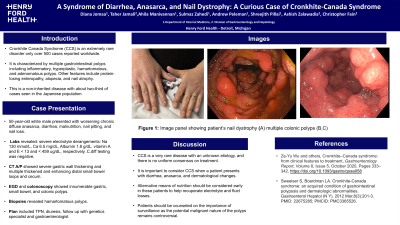Monday Poster Session
Category: General Endoscopy
P2022 - A Syndrome of Diarrhea, Anasarca, and Nail Dystrophy: A Curious Case of Cronkhite-Canada Syndrome
Monday, October 23, 2023
10:30 AM - 4:15 PM PT
Location: Exhibit Hall

Has Audio

Diana Jomaa, MD
Henry Ford Hospital
Dearborn, MI
Presenting Author(s)
Award: Presidential Poster Award
Diana Jomaa, MD1, Taher Jamali, MD1, Ahila Manivannan, MD2, Sulmaz Zahedi, MD1, Andrew Peleman, DO1, Shreejith Pillai, MD1, Ashish Zalawadia, MD1, Christopher Fain, DO1
1Henry Ford Hospital, Detroit, MI; 2Henry Ford Health, Detroit, MI
Introduction: Cronkhite Canada Syndrome (CCS) is an extremely rare disorder only over 500 cases reported worldwide. It is characterized by multiple gastrointestinal polyps including inflammatory, hyperplastic, hamartomatous, and adenomatous polyps. Other features include protein-losing enteropathy, alopecia, and nail atrophy. This is a non-inherited disease with about two-third of cases seen in the Japanese population.
Case Description/Methods: A 50 year old white male with a history of recurrent Clostridium difficile (C. diff.) infections presented to the hospital with 7 months of worsening diffuse anasarca, diarrhea, malnutrition, nail pitting, and eventual nail loss. He has had many admissions for similar symptoms in the past few months and has been treated for recurrent C. diff. infections. Laboratory evaluation on this presentation revealed severe electrolyte derangements including hyponatremia (130 mmol/L), hypocalcemia (6.5 mg/dL), hypoalbuminemia (1.8 g/dL), vitamin A and E deficiency (< 13 and < 459 ug/dL, respectively). C.diff testing was negative. CT scan of his abdomen and pelvis showed severe gastric wall thickening, perigastric and mesenteric adenopathy, and multiple thickened and enhancing distal small bowel loops and cecum. Patient underwent endoscopy and colonoscopy that showed innumerable gastric, small bowel, and colonic polyps. Biopsies were taken from polypoid areas of the stomach, duodenum, and colon, and background colonic mucosa. Separate fragments of polypoid and non-polypoid colonic mucosa as well as gastric and duodenal biopsy fragments from polypoid mucosa revealed lamina propria edema, acute inflammation, cystically dilated glands and reactive changes, suggestive of hamartomatous polyps. Findings were overall consistent with a diagnosis of CCS. Patient was started on total parenteral nutrition and was treated with intravenous diuresis with overall improvement in peripheral edema. He was discharged home with plans to follow up with a genetics specialist and gastroenterologist.
Discussion: CCS is a very rare disease with an unknown etiology, and there is no uniform consensus on treatment. It is important to consider CCS when a patient presents with diarrhea, anasarca, and dermatological changes. In addition, alternative means of nutrition should be considered early in these patients to help recuperate electrolyte and fluid losses. Patients should be counseled on the importance of surveillance as the potential malignant nature of the polyps remains controversial.

Disclosures:
Diana Jomaa, MD1, Taher Jamali, MD1, Ahila Manivannan, MD2, Sulmaz Zahedi, MD1, Andrew Peleman, DO1, Shreejith Pillai, MD1, Ashish Zalawadia, MD1, Christopher Fain, DO1. P2022 - A Syndrome of Diarrhea, Anasarca, and Nail Dystrophy: A Curious Case of Cronkhite-Canada Syndrome, ACG 2023 Annual Scientific Meeting Abstracts. Vancouver, BC, Canada: American College of Gastroenterology.
Diana Jomaa, MD1, Taher Jamali, MD1, Ahila Manivannan, MD2, Sulmaz Zahedi, MD1, Andrew Peleman, DO1, Shreejith Pillai, MD1, Ashish Zalawadia, MD1, Christopher Fain, DO1
1Henry Ford Hospital, Detroit, MI; 2Henry Ford Health, Detroit, MI
Introduction: Cronkhite Canada Syndrome (CCS) is an extremely rare disorder only over 500 cases reported worldwide. It is characterized by multiple gastrointestinal polyps including inflammatory, hyperplastic, hamartomatous, and adenomatous polyps. Other features include protein-losing enteropathy, alopecia, and nail atrophy. This is a non-inherited disease with about two-third of cases seen in the Japanese population.
Case Description/Methods: A 50 year old white male with a history of recurrent Clostridium difficile (C. diff.) infections presented to the hospital with 7 months of worsening diffuse anasarca, diarrhea, malnutrition, nail pitting, and eventual nail loss. He has had many admissions for similar symptoms in the past few months and has been treated for recurrent C. diff. infections. Laboratory evaluation on this presentation revealed severe electrolyte derangements including hyponatremia (130 mmol/L), hypocalcemia (6.5 mg/dL), hypoalbuminemia (1.8 g/dL), vitamin A and E deficiency (< 13 and < 459 ug/dL, respectively). C.diff testing was negative. CT scan of his abdomen and pelvis showed severe gastric wall thickening, perigastric and mesenteric adenopathy, and multiple thickened and enhancing distal small bowel loops and cecum. Patient underwent endoscopy and colonoscopy that showed innumerable gastric, small bowel, and colonic polyps. Biopsies were taken from polypoid areas of the stomach, duodenum, and colon, and background colonic mucosa. Separate fragments of polypoid and non-polypoid colonic mucosa as well as gastric and duodenal biopsy fragments from polypoid mucosa revealed lamina propria edema, acute inflammation, cystically dilated glands and reactive changes, suggestive of hamartomatous polyps. Findings were overall consistent with a diagnosis of CCS. Patient was started on total parenteral nutrition and was treated with intravenous diuresis with overall improvement in peripheral edema. He was discharged home with plans to follow up with a genetics specialist and gastroenterologist.
Discussion: CCS is a very rare disease with an unknown etiology, and there is no uniform consensus on treatment. It is important to consider CCS when a patient presents with diarrhea, anasarca, and dermatological changes. In addition, alternative means of nutrition should be considered early in these patients to help recuperate electrolyte and fluid losses. Patients should be counseled on the importance of surveillance as the potential malignant nature of the polyps remains controversial.

Figure: Figure 1: Image Panel showing patient's nail dystrophy (A) and multiple polyps seen in colon (B and C)
Disclosures:
Diana Jomaa indicated no relevant financial relationships.
Taher Jamali indicated no relevant financial relationships.
Ahila Manivannan indicated no relevant financial relationships.
Sulmaz Zahedi indicated no relevant financial relationships.
Andrew Peleman indicated no relevant financial relationships.
Shreejith Pillai indicated no relevant financial relationships.
Ashish Zalawadia indicated no relevant financial relationships.
Christopher Fain indicated no relevant financial relationships.
Diana Jomaa, MD1, Taher Jamali, MD1, Ahila Manivannan, MD2, Sulmaz Zahedi, MD1, Andrew Peleman, DO1, Shreejith Pillai, MD1, Ashish Zalawadia, MD1, Christopher Fain, DO1. P2022 - A Syndrome of Diarrhea, Anasarca, and Nail Dystrophy: A Curious Case of Cronkhite-Canada Syndrome, ACG 2023 Annual Scientific Meeting Abstracts. Vancouver, BC, Canada: American College of Gastroenterology.


